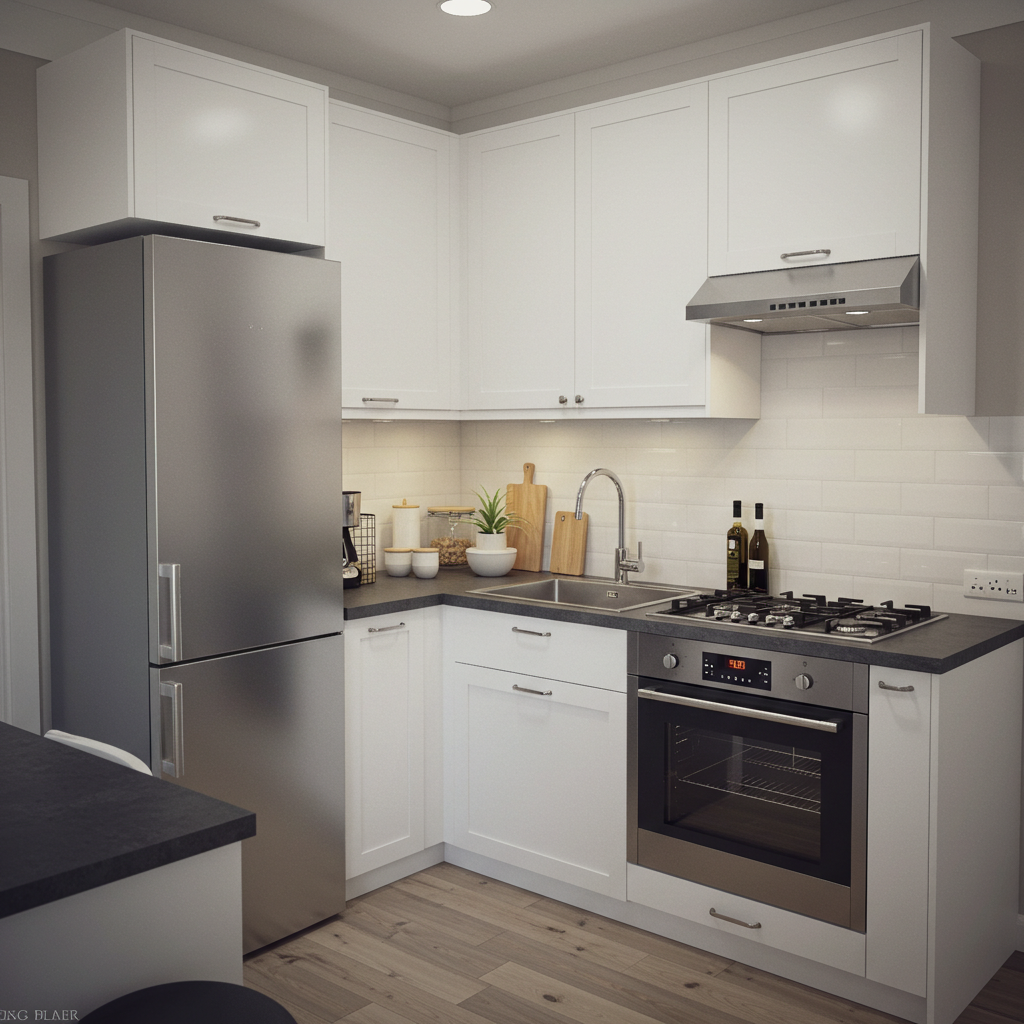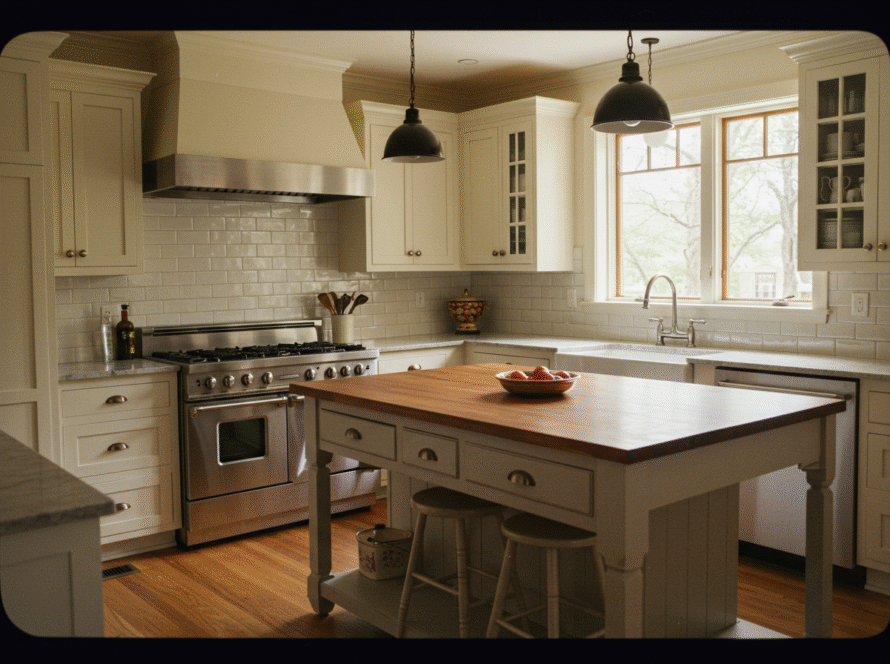
Understanding the Challenges of a Small Kitchen Designing a small kitchen presents a unique set of challenges that can significantly impact its functionality and aesthetics. One of the primary issues faced is limited storage space. Small kitchens often lack adequate cabinets and counter space to store appliances, cookware, and pantry items. Consequently, homeowners may find themselves resorting to clutter, which not only affects the kitchen’s appearance but can also hinder cooking efficiency.
Another challenge is the cramped work areas within small kitchens. With multiple tasks required in meal preparation, including chopping, cooking, and cleaning, having enough room to maneuver can be problematic. A congested layout can make it difficult for more than one person to work simultaneously, complicating the cooking process and making social interactions in the kitchen challenging.
The need for an efficient layout is paramount in overcoming these challenges. Designing a space that optimizes the flow of movement between various work zones – such as preparation, cooking, and cleaning – can significantly enhance functionality. Therefore, understanding the work triangle concept is essential, as it promotes a workflow that minimizes unnecessary movement while maximizing space utilization. This requires thoughtful consideration of every element, including appliance placement, work surfaces, and storage options.
Before embarking on the design process, it is crucial to measure the kitchen accurately and identify individual needs. This is because every small kitchen has different dimensions and unique characteristics that may influence the choice of materials, colors, and appliances. By taking the time to evaluate these aspects, homeowners can create a personalized and efficient kitchen design that embraces the challenges rather than succumbing to them.
Maximize Vertical Space with Smart Storage Solutions
In the realm of small kitchen design, effectively utilizing vertical space can drastically improve organization and accessibility. One of the most straightforward approaches is the incorporation of shelves that reach up to the ceiling.
This not only draws the eye upward, creating an illusion of height but also provides ample space for storing essential kitchen items. Optingfor open shelving can give a light and airy feel while allowing you to showcase decorative dishes and cookbooks, thus enhancing the kitchen’s aesthetic appeal.
Cleverly designed cabinets that extend to the ceiling eliminate wasted space and can conceal less frequently used items. Utilizing pull-down shelves or lazy Susans within upper cabinets can facilitate easier access to items stored at the back, ensuring that nothing is forgotten or difficult to retrieve. These solutions make the best use of vertical storage without compromising accessibility.
Wall-mounted organizers represent another inventive way to utilize vertical space. For instance, hanging pot racks can free up valuable counter space while providing a place to display cookware. Magnetic knife strips are not only practical for keeping knives within reach but also add a modern touch to your kitchen design. Additionally,you may consider hanging hooks for utensils or mugs, which helps to maintain a tidy countertop while keeping necessary tools close at hand.
Incorporating these smart storage solutions into your small kitchen design can transform cluttered spaces into functional areas that serve your culinary needs. By maximizing vertical space, you not only enhance the kitchen’s functionality but also its visual appeal, creating a space that feels both organized and inviting. As you explore these innovative storage strategies, consider how they will contribute to a more efficient kitchen experience while reflecting your personal style.
Choose the Right Color Palette for a Visually Expansive Look
Color selection plays a pivotal role in shaping the perception of space in any kitchen, particularly in smaller environments where every inch counts. Opting for light and neutral colors for your walls and cabinets can work wonders in creating an illusion of a more spacious area. Light shades such as whites, creams, soft beiges, and pale pastels are ideal, as they reflect natural light, helping the space feel airy and open. These hues can provide a clean and timeless backdrop, allowing other elements within the kitchen to stand out.
Incorporating bolder colors thoughtfully can also enhance your small kitchen’s aesthetic without overwhelming it. Using vibrant colors in accessories, such as dishware, curtains, or kitchen towels, adds a splash of personality while maintaining a lighter overall palette. Accent walls painted in deeper hues or incorporating colorful backsplashes made from tiles can serve as eye-catching focal points, contributing to a layered, dynamic design that enriches the space.
Additionally, the impact of reflective surfaces cannot be overstated. Using materials such as glossy tiles, glass cabinets, or metallic finishes can amplify the available light and create a shimmering effect, thereby expanding the visual dimensions of the kitchen. These surfaces act as mirrors, reflecting light and colors throughout the space, which can help in maintaining a bright and inviting atmosphere. By carefully balancing light and dark tones along with implementing reflective ideas, homeowners can achieve a harmonious design that maximizes both style and openness in a small kitchen.
Opt for Open Shelving to Create an Airy Feel
Open shelving has gained immense popularity in modern kitchen design, especially for those with limited space. One of the primary advantages of open shelving lies in its ability to create an airy and spacious feel within a small kitchen. By eliminating the bulk of traditional cabinetry, open shelves can visually expand the area, allowing for more light to flow throughout the space. Furthermore, open shelves offer homeowners the opportunity to showcase beautiful dishware, decorative items, and accents that reflect personal style and taste.
However, it is essential to consider the potential drawbacks of open shelving. Unlike closed cabinets, which can conceivably hide clutter, open shelves require consistent organization and cleaning. Items displayed on open shelves can easily accumulate dust, and without proper organization, the shelves may appear chaotic. To tackle these challenges, homeowners should establish a regular maintenance routine for their open shelves and adopt effective styling techniques.
When styling open shelves, consider a curated approach to display items. Group similar items together and use the rule of threes, where objects are arranged in sets of three for visual interest. Incorporate decorative baskets or bins to hold smaller items while maintaining a cohesive look. Mixing and matching textures, such as incorporating wooden cutting boards, ceramic dishes, and glass containers can add depth and dimension to the display.
It is equally important to keep the most frequently used items at eye level for easy access, while storing less frequently used items higher up. Remember that an organized and thoughtfully styled open shelf can serve as both a practical storage solution and an attractive focal point in the kitchen. Through careful planning and organization, open shelving can transform a small kitchen into a more inviting and functional space.
Integrate Multi-Functional Furniture and Appliances
In the realm of small kitchen design, the integration of multi-functional furniture and appliances is pivotal for maximizing both space and usability. By carefully selecting pieces that serve dual or even multiple purposes, homeowners can significantly enhance their kitchen experience without compromising on style or efficiency. One of the foremost options is the use of foldable tables. These versatile pieces can be extended when additional surface area is needed, such as during family meals or food preparation, and conveniently collapsed and stored away when not in use. This flexibility is crucial in a compact area where every square foot counts.
Another excellent choice is benches or seating that incorporate storage. Consider implementing a bench with built-in compartments that can house utensils, pots, or even small kitchen gadgets. Such a solution not only provides seating but also prevents clutter, lending a clean and organized appearance to your kitchen. Similarly, appliances that embody multi-functionality, such as a microwave oven that also grills or air fries, can substantially free up countertop space while maximizing culinary capabilities.These innovative machines are designed to perform several tasks, allowing for a streamlined cooking process and minimizing the need for multiple devices.
When arranging these items, it is essential to think strategically. Distributing multi-functional pieces evenly throughout the kitchen helps establish a flow that enhances usability. For instance, placing a foldable table near the prep area or utilizing a storage bench near the cooking zone can create an efficient work triangle. Innovative solutions like pull-out cabinets or drawer organizers can also enhance accessibility to frequently used items. By thoughtfully integrating multi-functional furniture and appliances, you can transform a small kitchen into a space that is not only functional but also enjoyable to use.
Effective Lighting Choices to Enhance Space Perception
Effective lighting is a crucial element in designing a small kitchen, as it can significantly influence the perceived space and overall ambiance. In a confined area, careful consideration of lighting types-ambient, task, and accent-is essential to create an inviting atmosphere while optimizing visual expansiveness.
Ambient lighting provides the base level of illumination and is fundamental for establishing a warm and welcoming environment. It can be achieved through overhead fixtures such as flush mounts or pendant lamps that create an even distribution of light throughout the kitchen. Choosing fixtures that emit a soft, warm glow can help in making the space feel larger and more comfortable.
Task lighting is designed to illuminate specific work areas, such as countertops and kitchen islands, where food preparation occurs. Under-cabinet lights are highly effective in this context, as they directly target these vital surfaces without introducing shadows. LED strip lights or puck lights can be installed beneath cabinets, providing focused illumination that enhances functionality while also contributing to the overall design aesthetics.
Accent lighting adds depth to the kitchen environment by highlighting architectural features, decorative elements, or shelving displays. Properly positioning accent lights can draw attention to these areas, creating an illusion of increased space. For instance, illuminating open shelving with small spotlights can add visual interest and help avoid a cluttered appearance.
Utilizing natural light is another vital consideration in small kitchen design. Where possible, installing larger windows or strategically positioned mirrors can increase daylight and reflect light throughout the space. Combining these various types of lighting effectively can enhance both the functionality and visual appeal of your small kitchen, transforming it into a well-lit and inviting area.
Personalized Decor: Adding Your Unique Style
Designing a small kitchen allows for the opportunity to infuse personal touches that reflect your unique style. The incorporation of decor that resonates with your personality can transform the atmosphere of your kitchen, making it not just a place for culinary tasks, but a space that showcases who you are. To achieve this, start by selecting art pieces that resonate with your aesthetic.Whether it’s vibrant paintings, framed family recipes, or photographs, these elements can provide a warm and inviting touch.
In addition to artwork, textiles play a crucial role in personalizing your kitchen. Consider incorporating unique table linens, curtains, or cushions in a color palette that matches your style. Fabrics can soften the hard edges of kitchen appliances and cabinetry, adding depth and an inviting touch. Furthermore, do not underestimate the value of unique kitchen gadgets and utensils, which can often serve as statement pieces. Items such as artisanal olive oil dispensers, handmade wooden cutting boards, or brightly colored cookware can enhance both the functionality and aesthetic appeal of the space.
However,it is essential to strike a balance between style and functionality. In a small kitchen, every item should serve a purpose while still contributing to the decor. Opt for multi-functional items that reflect your personal style, such as stylish storage solutions or decorative baskets. This approach ensures that the space remains clutter-freewhile still feeling personalized. Remember, the goal is to create an environment where culinary creativity flourishes, wrapped in an aesthetic that feels authentically you. Thoughtful integration of personalized decor with functional designs will result in a small kitchen that stands out, reflecting your unique identity without compromising practicality.



